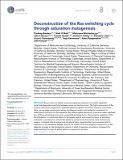Deconstruction of the Ras switching cycle through saturation mutagenesis
Author(s)
Bandaru, Pradeep; Shah, Neel H; Bhattacharyya, Moitrayee; Barton, John P; Kondo, Yasushi; Cofsky, Joshua C; Gee, Christine L; Chakraborty, Arup K; Kortemme, Tanja; Ranganathan, Rama; Kuriyan, John; ... Show more Show less
Downloadelife-27810-v2.pdf (8.740Mb)
PUBLISHER_POLICY
Publisher Policy
Article is made available in accordance with the publisher's policy and may be subject to US copyright law. Please refer to the publisher's site for terms of use.
Terms of use
Metadata
Show full item recordAbstract
Ras proteins are highly conserved signaling molecules that exhibit regulated, nucleotide-dependent switching between active and inactive states. The high conservation of Ras requires mechanistic explanation, especially given the general mutational tolerance of proteins. Here, we use deep mutational scanning, biochemical analysis and molecular simulations to understand constraints on Ras sequence. Ras exhibits global sensitivity to mutation when regulated by a GTPase activating protein and a nucleotide exchange factor. Removing the regulators shifts the distribution of mutational effects to be largely neutral, and reveals hotspots of activating mutations in residues that restrain Ras dynamics and promote the inactive state. Evolutionary analysis, combined with structural and mutational data, argue that Ras has co-evolved with its regulators in the vertebrate lineage. Overall, our results show that sequence conservation in Ras depends strongly on the biochemical network in which it operates, providing a framework for understanding the origin of global selection pressures on proteins.
Date issued
2017-07Department
Institute for Medical Engineering and Science; Massachusetts Institute of Technology. Department of Biological Engineering; Massachusetts Institute of Technology. Department of Chemical Engineering; Massachusetts Institute of Technology. Department of Chemistry; Massachusetts Institute of Technology. Department of PhysicsJournal
eLife
Publisher
eLife Sciences Publications, Ltd
Citation
Bandaru, Pradeep et al. “Deconstruction of the Ras Switching Cycle through Saturation Mutagenesis.” eLife 2017, 6 (July 2017): e27810 © Bandaru et al
Version: Final published version
ISSN
2050-084X